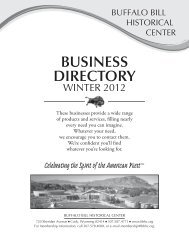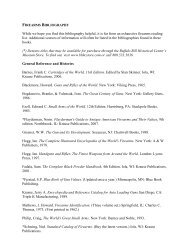BLM WY Golden Eagle Research and Monitoring - Buffalo Bill ...
BLM WY Golden Eagle Research and Monitoring - Buffalo Bill ...
BLM WY Golden Eagle Research and Monitoring - Buffalo Bill ...
You also want an ePaper? Increase the reach of your titles
YUMPU automatically turns print PDFs into web optimized ePapers that Google loves.
STUDY AREA<br />
The Bighorn Basin lies at the eastern edge of the Greater Yellowstone Ecosystem,<br />
in northwestern Wyoming. It is one of the last large, virtually intact native sagebrushsteppe<br />
tracts left in the Intermountain West. Except for a narrow gap to the northwest,<br />
the Basin is surrounded by high elevation ecosystems of the Absaroka, Beartooth, <strong>and</strong><br />
Bighorn mountain ranges. Flat <strong>and</strong> rolling terrain is broken sharply by s<strong>and</strong>stone<br />
outcroppings, cliffs, <strong>and</strong> ravines. Depending on local soil characteristics <strong>and</strong> topography,<br />
native vegetation is dominated by a complex of shrubs, e.g., big sagebrush (Artemisia<br />
tridentata), greasewood (Sarcobatus vermiculatus), saltbush (Atriplex spp.) <strong>and</strong><br />
rabbitbrush (Chrysothamnus spp.), grasses, e.g., bluebuch wheatgrass (Agropyron<br />
spicatum), western wheatgrass (Agropyron smithii), S<strong>and</strong>berg bluegrass (Poa<br />
s<strong>and</strong>bergerii), <strong>and</strong> needle-<strong>and</strong>-thread (Stipa comata), <strong>and</strong> forbs, e.g., scarlet<br />
globemallow (Sphaeralcea coccinea) <strong>and</strong> penstemon (Penstemon spp.). Plains<br />
cottonwood <strong>and</strong> willows occupy wetter drainages. Invasive species include cheatgrass<br />
(Bromus tectorum), tamarisk (Tamarix spp.), <strong>and</strong> Russian olive (Elaeagnus angustifolia).<br />
The large, relatively unbroken swath of sagebrush-steppe habitat in the Bighorn<br />
Basin provides important seasonal or year-round sustenance for wildlife native to the<br />
Greater Yellowstone Ecosystem. Mammals using the Basin either year-round or<br />
seasonally include pronghorn (Antilocapra americana), mule (Odocoileus hemionus) <strong>and</strong><br />
white-tailed deer (O. virginianus), elk (Cervus elaphus), bighorn sheep (Ovis<br />
canadensis), free-ranging horse (Equus ferrus), white-tailed prairie dog (Cynomys<br />
ludovicianus), white-tailed jackrabbit (Lepus townsendii), desert cottontail (Sylvilagus<br />
audubonii), black bear (Ursus americanus), badger (Taxidea taxus), coyote (Canis<br />
6






